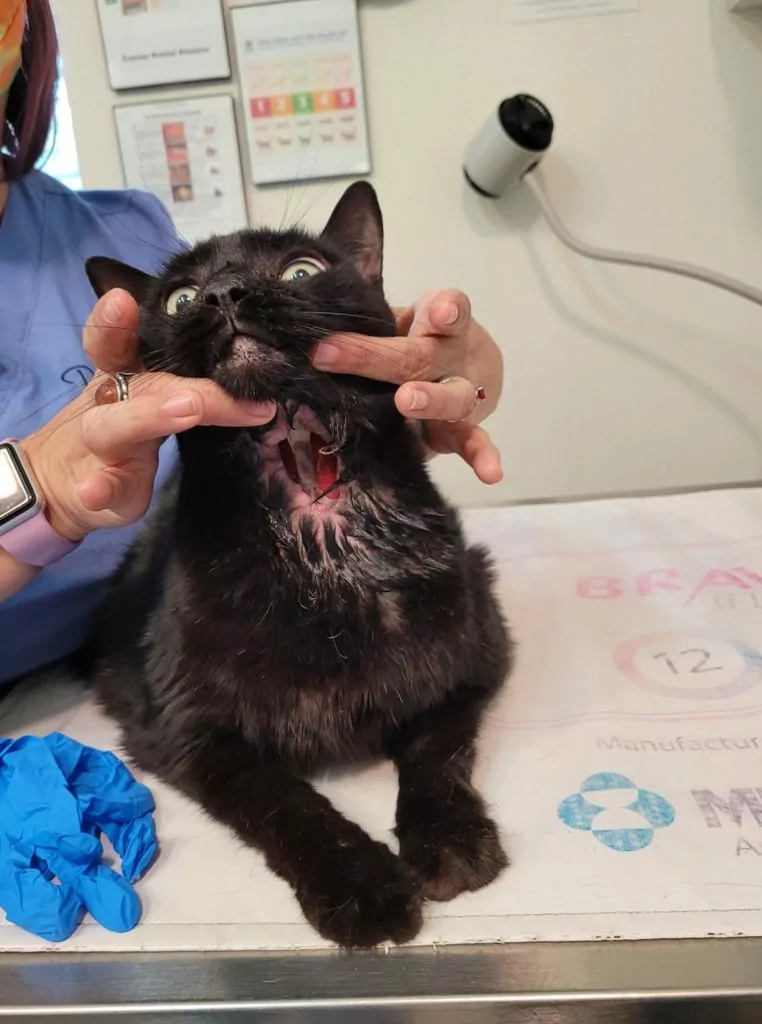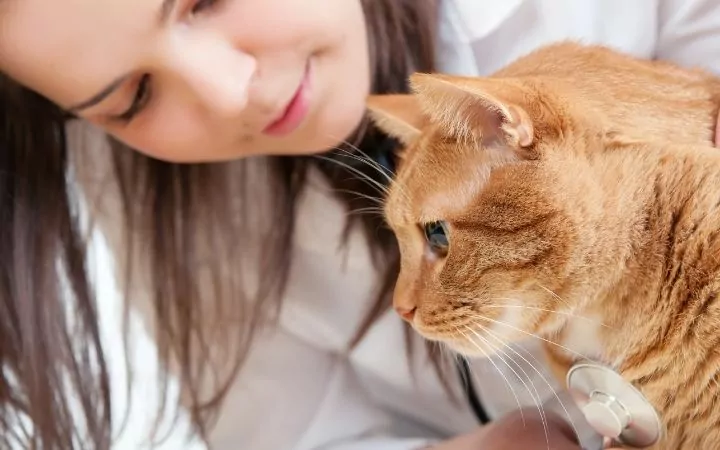What is a Cat Cyst?
The cat cyst and other lumps and bumps. When you feel a lump on your cat, you might get a fright, especially if it seemingly appeared overnight. Lumps and bumps of all types can develop on our feline friends.
Today, we will focus on cysts and mention other causes of what you might have found. A cyst on the skin is growth filled with fluid or semisolid material,
As always, if you find a mass on your pet, always get it checked out by a veterinarian. While many lumps look similar, the treatment and prognosis can vary greatly, so it needs to be correctly diagnosed.
If you like a quick version of this article, watch this video >
A List of Different Feline Cysts and other Bumps and Lumps

There are five different types of cysts, namely:
True cysts which is the most common type. True cysts form in glands such as sweat glands. When they become blocked, the fluid builds and creates a cyst. True cysts are usually lined with a secretory membrane which means even when it is drained, the fluid will continue to build up. Removal is the only cure.
Follicular cysts, which are unusual in cats, these develop in hair follicles. The most common type of follicular cyst we see in cats is feline acne.
Sebaceous cysts develop from the sebaceous glands, which produce sebum, the most common type of sebaceous cyst we see in cats is stud tail.
Dermoid cysts develop during development in the womb. These are very rare.
False cysts. As the name suggests, these don’t fit the standard definition of cysts. These occur when bleeding or trauma happens. Blood and dead tissue become trapped under the skin. These are also rare in cats.
When you find a lump, your mind may jump to the worst-case scenario, but actually, there are many different causes of lumps. A few of which are mentioned below.
Cysts
As mentioned previously, these are not cancerous, but treatment can vary. If they are causing a problem, they may need to be surgically removed or drained.
Abscesses

These form when an infection develops under the skin and fills up with pus. The most common cause of abscesses in cats is from fighting or hunting. Often these feel soft to the touch, or they can feel hot, and it may be painful for your cat when you touch them. These are not cancerous but do need to be treated by your veterinarian either through medicine or surgery.
Granulomas
They occur when an area of skin is repeatedly inflamed or infected. The affected skin is often thickened and bright pink or red. Often these develop on the face or between the back legs. These can often be associated with allergies, and it’s essential to get to the bottom of the cause so that treatment can be successful. These are also not cancerous but need to be treated.
Tumors
Tumors develop from abnormal growth of cells. Tumors can be cancerous or non-cancerous. The only way to diagnose a tumor is by taking a sample and analyzing it by a pathologist. This can be done in consultation through a fine needle aspirate or surgically through a biopsy. Once a diagnosis is made, treatment can vary depending on the disease.
Examples of common tumors include lipomas (non-cancerous fatty lumps), squamous cell carcinomas (cancerous, often found on hairless areas of white cats such as the ears), and Mast Cell Tumours (cancerous, can look very different depending on the type).
Ticks

Indoor and outdoor cats can get ticks. These are tiny bluish arachnids (in the spider family) that attach to the cat and suck out blood. Ticks can carry serious diseases, so it is important to include anti-tick medicine in your cat’s parasite control.
Lymph nodes and nipples
These can sometimes feel like scary lumps but are standard parts of the anatomy. Lymph nodes are all over the body but are most commonly felt behind the knee or under the jaw. Nipples occur on male and female cats, there are usually eight, but this can vary.
If you do get told that the lump you found was a nipple or lymph node, don’t be embarrassed, your veterinarian would prefer you get it checked out rather than leave it, and it is something more serious.
The Signs and Causes of Cat Cysts
Now that you know there are five different types of cysts, you can understand that this means there is variation in what we see in their signs:
- True cysts will often be round and soft to the touch. They can appear translucent or have a blue hue. The material inside is often very watery (like sweat); they rarely have a smell. The hair covering true cysts can fall out.
- Follicular cysts such as “feline acne” will often be present under the chin. There can be single or multiple round nodules with thick yellow or grey material inside (keratin). These can become infected.
- Sebaceous cysts, as seen in “stud tail” can appear as single or multiple raised bumps which can be white or blue. The material inside is often thick and like cottage cheese.
- False cysts, when filled with blood, will often look dark. They can appear anywhere on the body. They are associated with trauma, so they could be painful to touch and may be associated with other injuries such as broken bones.
- All cysts have the potential to become infected, which may change their appearance. You mustn’t overly touch any cyst on your pet too much or attempt to drain it at home as this can lead to infection, which can be very serious.
- Cysts can also rupture and leak the material inside. In this case, you may notice a wet patch on your cat’s fur or see them licking.
How is the Cat Cyst Diagnosed?

Your vet may suspect a cyst from history collected from you and by examining your cat. Often a diagnostic test will be required to confirm their suspicion. The most common diagnostic tests performed for a cyst are fine needle aspirates and biopsies.
A fine needle aspirate involves collecting fluid from the mass either by pushing a needle into the swelling or squeezing out material. This is not an invasive procedure and can usually be done during the consultation. The fluid collected can then be sent to a diagnostic laboratory to be examined by a pathologist under a microscope. This is called cytology.
A biopsy involves surgically removing a piece of tissue and having it sent to a diagnostic laboratory. This tissue can be a piece of the mass (incisional biopsy) or the entire thing (excisional biopsy). This can then also be examined by a pathologist in a process called histology.
What is the Treatment of Cysts in Cats?
Once a diagnosis is made treatment can vary from leaving it alone, medical management, or surgical management.
Leaving it alone
This may be recommended if the cyst is not bothering your pet too much or if there’s a reason why surgery isn’t an option, such as if they are sick or old. If it’s recommended to leave the cyst alone, it’s still important to monitor the area for any sudden changes and make sure your pet is still acting normally.
Do not attempt to drain the cyst yourself unless your veterinarian has recommended it. If the cyst changes, treatment may be required.
Medical treatment
This may involve antibiotics if the cyst is infected or possibly regular draining if it is getting too full. For feline acne, the area might need to be regularly cleaned with a medical wash, or changes to diet and food bowls could be recommended.
If your veterinarian recommends draining at home, it is essential to pay close attention to hygiene, not to introduce infection into the sterile cyst as this can be serious and could require surgery.
Surgical management
This usually involves removing the entire cyst and affected tissues. This is often the only treatment for true cysts as they will continue to fill up when drained. A cyst might also be removed if it becomes infected or if it is painful to your pet or they keep traumatizing it.
Stud tail is often associated with testosterone, so neutering your male cat may help with treatment.
When Should You Take Your Cat to the Vet?

Whenever you see a mass on your pet, it is essential to have it examined. Hopefully, the lump will be nothing, and it will put your mind at ease, but it also could be more severe, and you’ll be glad you had it checked promptly.
If you notice a lump and your cat is also unwell, this could be serious so getting your cat seen as soon as possible is a good idea.
Summary
In this article we have discussed cysts and other lumps and bumps your cat may develop.
Cysts in cats are rarely life-threatening or cause for serious concern.
However, it is essential to get your cat seen whenever you notice a new lump so that you can appropriately treat it, especially if they are unwell.
With appropriate management, your cat can live a healthy life with a cyst or even have it removed for a more permanent solution.
